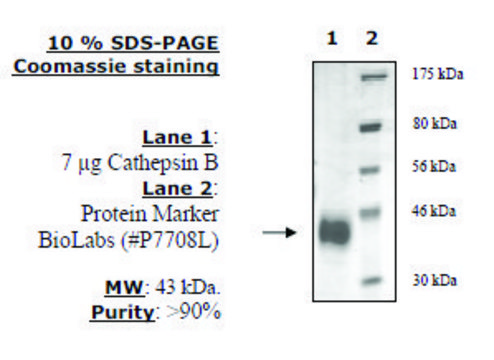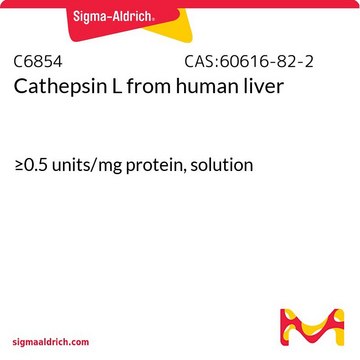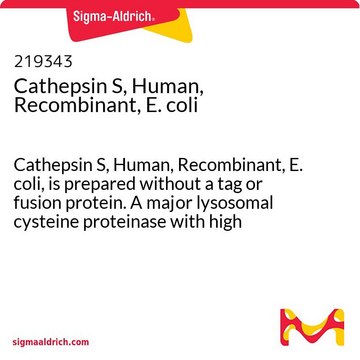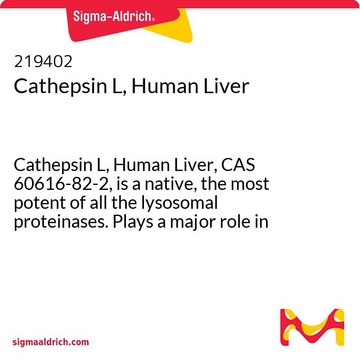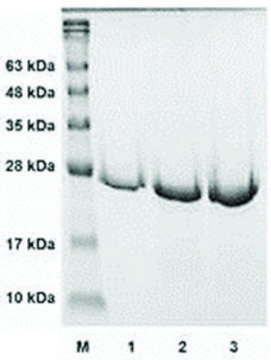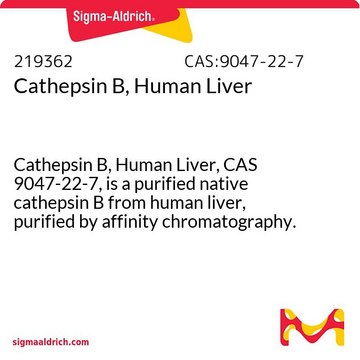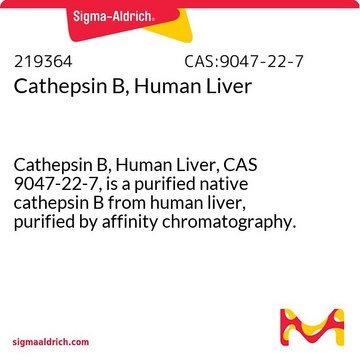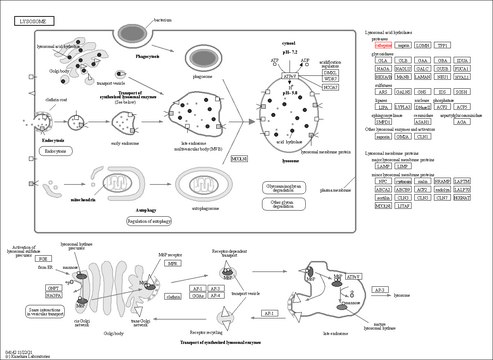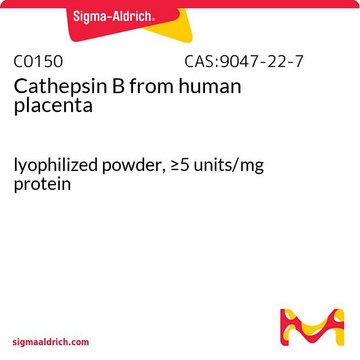推荐产品
生物来源
human
重组
expressed in FreeStyle™ 293-F cells
方案
≥90% (SDS-PAGE)
表单
aqueous solution
比活
≥8100 pmol/min-μg
分子量
37 kDa
技术
activity assay: suitable
适用性
suitable for molecular biology
NCBI登记号
应用
life science and biopharma
运输
dry ice
储存温度
−70°C
基因信息
human ... CTSS(1520)
一般描述
Research area: Cell Signaling
Human cathepsin S (GenBank Accession No. NM_004079.3), CD33 signal peptide (amino acids 1-16) + cathepsin S (amino acids 17-331), with C-terminal HIS tag, MW = 37 kDa, expressed in FreeStyle 293-F cells. Cathepsin S belongs to the cysteine cathepsin protease family. It has limited tissue expression, being associated with antigen-presenting cells localized in lymph and spleen, as well as other immune cells like macrophages. Human cathepsin S is produced from its corresponding CTSS gene on chromosome 1q21 and is synthesized as a pre-proenzyme.
Human cathepsin S (GenBank Accession No. NM_004079.3), CD33 signal peptide (amino acids 1-16) + cathepsin S (amino acids 17-331), with C-terminal HIS tag, MW = 37 kDa, expressed in FreeStyle 293-F cells. Cathepsin S belongs to the cysteine cathepsin protease family. It has limited tissue expression, being associated with antigen-presenting cells localized in lymph and spleen, as well as other immune cells like macrophages. Human cathepsin S is produced from its corresponding CTSS gene on chromosome 1q21 and is synthesized as a pre-proenzyme.
应用
Active human cathepsin S has been used:
- to assess the pathogenesis of Alzheimer′s disease.
- to investigate the optimization of selectivity of Azepanone-based inhibitors.
- for the immunocytochemical detection of cathepsin-S in mouse samples.
- for incubating mouse brain sections to test the impact of cathepsin-S on perineuronal nets (PNNs) integrity.
生化/生理作用
Cathepsin S, as a lysosomal protease, facilitates the breakdown of unwanted and damaged proteins in the endo-lysosomal pathway. Moreover, it plays specific roles, such as contributing to major histocompatibility complex (MHC) class II antigen presentation by aiding in the degradation of the invariant chain. Dysregulation of cathepsin S has been associated with various pathological conditions, such as cancer, arthritis, and cardiovascular disease. Cathepsin S is useful for the study of enzyme kinetics, screening inhibitors, and selectivity profiling. It is also used as a biomarker for atherosclerosis, diabetes, adiposity, and atherogenesis. Moreover, it acts as a promising target against brain-penetrating and for the treatment of multiple sclerosis and neuropathic pain.
单位定义
One unit is defined as the amount of enzyme that will cleave 1 pmol of substrate per min at 37°C
外形
Formulated in 45 mM Tris-HCl, pH 8.0, 124 mM NaCl, 2.4 mM KCl, 225 mM imidazole, 3 mM DTT, and 10% glycerol.
制备说明
Thaw on ice. Upon first thaw, briefly spin tube containing enzyme to recover full content of the tube. Aliquot enzyme into single use aliquots. Store remaining undiluted enzyme in aliquots at -70°C. Note: Enzyme is very sensitive to freeze/thaw cycles.
法律信息
FreeStyle is a trademark of Invitrogen Corp.
警示用语:
Danger
危险声明
危险分类
Eye Irrit. 2 - Repr. 1B - Skin Irrit. 2
储存分类代码
6.1C - Combustible acute toxic Cat.3 / toxic compounds or compounds which causing chronic effects
WGK
WGK 3
闪点(°F)
Not applicable
闪点(°C)
Not applicable
法规信息
常规特殊物品
历史批次信息供参考:
分析证书(COA)
Lot/Batch Number
D Brömme et al.
Protein science : a publication of the Protein Society, 5(4), 789-791 (1996-04-01)
We have expressed active human cathepsin S to 60 mg/L in Sf9 cells using a baculovirus system. Production of milligram quantities has facilitated crystallographic studies to determine the structure of this enzyme, which has unique properties among lysosomal cysteine proteinases.
Harry Pantazopoulos et al.
eNeuro, 7(4) (2020-07-29)
Perineuronal nets (PNNs) are extracellular matrix (ECM) structures that envelop neurons and regulate synaptic functions. Long thought to be stable structures, PNNs have been recently shown to respond dynamically during learning, potentially regulating the formation of new synapses. We postulated
Richard D A Wilkinson et al.
Biological chemistry, 396(8), 867-882 (2015-04-16)
Cathepsin S is a member of the cysteine cathepsin protease family. It is a lysosomal protease which can promote degradation of damaged or unwanted proteins in the endo-lysosomal pathway. Additionally, it has more specific roles such as MHC class II
Azepanone-based inhibitors of human cathepsin S: optimization of selectivity via the P2 substituent.
Jeffrey K Kerns et al.
Bioorganic & medicinal chemistry letters, 21(15), 4409-4415 (2011-07-08)
A series of azepanone inhibitors of cathepsin S is described. Selectivity over both cathepsin K and cathepsin L was achieved by varying the P2 substituent. Ultimately, a balanced potency and selectivity profile was achieved in compound 39 possessing a 1-methylcyclohexyl
Israel Schechter et al.
Biological chemistry, 392(6), 555-569 (2011-05-19)
β-site APP-cleaving enzyme (BACE1) cleaves the wild type (WT) β-site very slowly (k(cat)/K(m): 46.6 m(-1) s(-1)). Therefore we searched for additional β-secretases and identified three cathepsins that split the WT β-site much faster. Human cathepsin S cleaves the WT β-site
我们的科学家团队拥有各种研究领域经验,包括生命科学、材料科学、化学合成、色谱、分析及许多其他领域.
联系技术服务部门